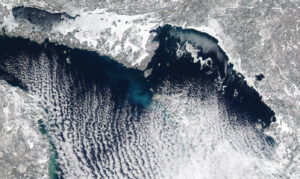2023-May-05
Decreasing Great Lakes Ice Cover has Consequences

Georgian Bay ice coverage as of February 20, 2023
According to the National Oceanic and Atmospheric Administration (NOAA), as of February 13, 2023, only 7% of the Great Lakes were covered by ice. This is significantly below the 35-40% ice cover expected for that time of year. Great Lakes scientists are working to better understand the importance of winter and ice to the Great Lakes ecosystems.
Warming winters and less coverage can leave shorelines and properties exposed to erosion and extreme winter storms. Lake effect storms, which occur when a cold air mass moves over an expanse of open water, produce heavier precipitation and are also becoming more common.
Thick, stable ice is also necessary to develop and protect fish eggs that incubate over the winter. Biologists are noting that smaller eggs can be produced in shorter winters. Mild winters also result in higher concentrations of nutrients like phosphorus and nitrogen from sediments in shallower areas which may contribute to summer algal blooms. Ice cover allows these nutrients to settle to the bottom of the lakes.
Read more here.
